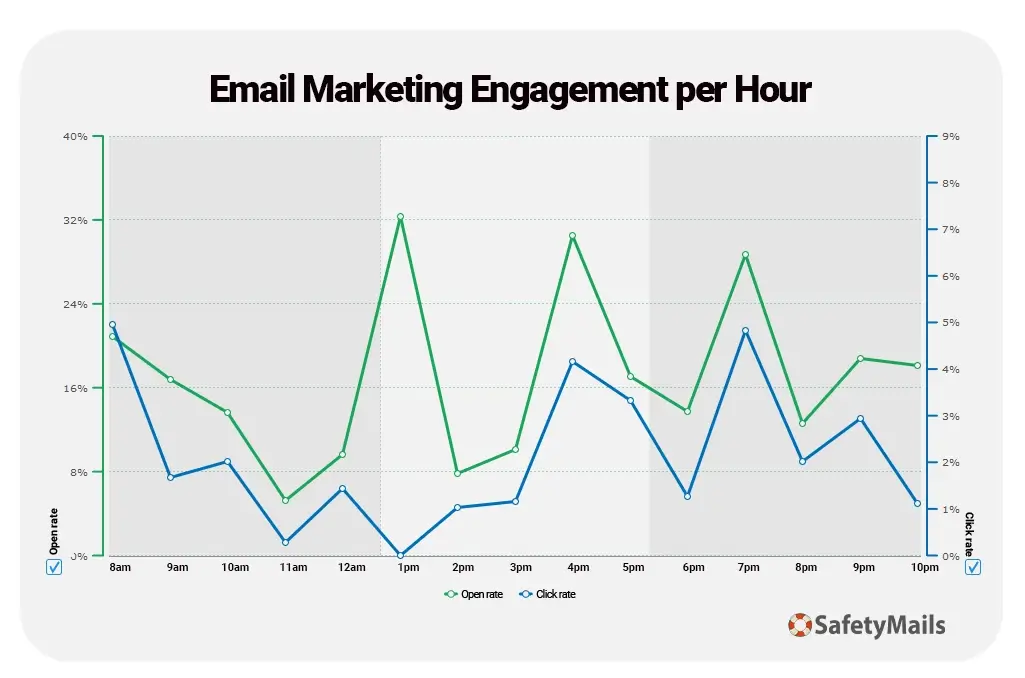One of the main secrets of email marketing conversion is related to the sending time.
EMAIL MARKETING STRATEGIES – If you are reading this article, you probably want to increase the engagement rate of your email marketing and hit the nail on the head on the best interaction time for recipients is part of (but not only) the factors that increase your opening rates.
The fact is that we invariably seek a simple and straightforward answer, with the best day and the best time to send the email marketing. But that would be a total incoherence
Table of contents
Beware of infallible recipes
Imagine the following scenario: You accept the maxim of the marketplace that says the best days for email marketing are Tuesdays and Thursdays, and the best time is 10am on those days.
Very well. In possession of the “golden egg hen” you (and the entire market who read the same article with the promising data) resolves to carry out the submissions of all the campaigns on a Tuesday at 10 o’clock in the morning.
If the entire Brazilian market decides to send their emails that day and at that time, a major bottleneck will occur with the providers, which have limits on the number of simultaneous connections that they are able to manage per second. In addition, providers prioritize email messages sent one-to-one, and not those of email marketing, which works in one-to-many format.
Shipments would slow down and consequently there would be a lot of campaign blocking, connection failures and timeout issues, leading to delays in deliveries and a drop in results.
Even if all the emails were delivered, there would be a flood of new messages in the recipients’ email boxes (after all, the same recipient may be present in the mailing lists of several senders). This would lead to a mass email deletion process, as recipients would prioritize reading what they considered most important.
Trend is not rule, but direction
Obviously, there is a lot of research that argues that the greatest number of interactions actually takes place between Tuesday and Thursday between 8 and 10 in the morning. It is well known in the market that people usually open their e-mails in the morning. That’s a trend.
However, the trend refers to the general group and is susceptible to dozens of factors that influence the fluctuation of this scenario.
Take, for example, this Adobe’s survey, which says that the number of hours spent reading email reaches 5.4 hours (3.3 hours for work and 2.1 hours for personal e-mails) , we understand that this behavior is not limited to the early hours of the morning
Plus, today we have mobile devices. In a competitive and connected environment, work emails are read all day long, using various devices. That wouldn’t be restricted to the time between 8 and 10 in the morning.
The Deloitte mobile consumer survey of 2016 states that 40% of consumers check their phones within 5 minutes of waking up, 30% up to 5 minutes before bedtime, and 50% in the middle of the night! This concurs , even, with studies that show good conversion rates during the night.
How about we leave the obvious
A universe of possibilities opens when these data spread out and analyzed coldly. The fact is that, although there are many interactions in the period from 8 to 10 in the morning, emails are read all day (and part of the dawn too). Experiencing interactions at alternative times to the mainstream can result in a positive surprise for the business.
Focus on your history and public
Understanding the needs of your audience, how it interacts, how the market operates where it’s inserted, and whats your engagement and conversion history in your previous actions helps determine the course corrections and adjustments in upcoming email marketing campaigns.
Public behavior and preferences affect directly on how they interact in email marketing.
An email intended for B2B would not have a good result if sent on Friday afternoon (probably). But what about an email related to entertainment? As an event, a race, exhibition, etc? A discount voucher? Maybe these emails had a lot more audience in an alternative delivery schedule, because the imminence of the event makes the content of the email more relevant.
Do you see how public, day, time, and content are closely connected?
Take a look at this chart from MailChimp (we also recommend reading their research – it’s very interesting) and note how there can be campaign types that perform better at alternate times and days.

Interaction and Segmentation History
Take the time to follow your own interaction histories. They will certainly indicate results that make all the difference in your day and time schedule.
See this image of a consolidated hourly engagement in email marketing campaigns, according to SafetyMails:

Notice how there are more than one peak business hours for campaign interactions, and they do not follow the morning mailing rule.
You can use this type of data to reschedule your email marketing at times best suited to your audience’s behavior and also target your submissions in more than one schedule. Yes, the same campaign divided into different schedules to meet with a higher degree of accuracy its recipients. Cool, huh?
Like everything else in email marketing, there is no recipe that works the same for everyone. There are, of course, trends and success stories that help us better guide our own strategies. These numbers and information are like a compass. But understanding how specific segments of the market respond to different stimuli allows us to fine-tune these strategies to get the best results.
Why is it important to implement an email verification service in your strategy?
When you build an email database, you surely want to have real people connected in your lists.
However, many people give a fake email address or an invalid one. They can simply make silly spelling mistakes during the registration process in your landing page or newsletters, for example.
SafetyMails has an expertise in prevent your whole strategy went to waste because you ended up with several addresses that are not fit to use. In other words, using our email verifier, your collected addresses are real, and can generate engagement.
In case of typos, the service can solicit corrections and reviews, making sure you don’t lose a promising lead. Everything happens in real-time and the email checker api is accurate and fast.
Would you like to know us better? Test now and check emails for free!
Choose SafetyMails email verification tool and see how easy it is to make sure no invalid or harmful addresses get to your subscriber lists!



